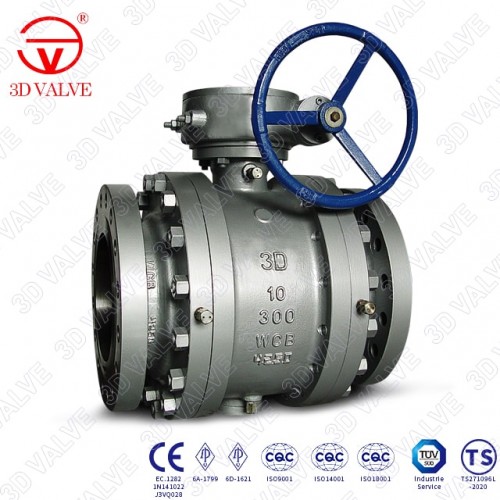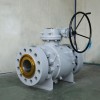





Product overview
3D supplies a wide range of side entry metal-seated trunnion mounted ball valves for 150LB~2500LB applications at -46~450℃. The metal seat provides an optimal resistance against wear caused by abrasive services or hard particles.
Size:2"~48"(DN50~DN1200)
Pressure Rating: ASME CLASS 150~2500(PN16~PN420)
Body material:Carbon steel, Stainless steel, Alloy steel, Duplex stainless steel, exotic alloy etc.
End connection: FLNG, BW,etc.
Operation:Manual, Pneumatic, Electric, Hydraulic.
The difference between soft and hard sealing of valves can be analyzed from the following five aspects:
1. Structural mechanism
The hard seal of ball valve is the seal between metal and metal, and the sealing ball and valve seat are metal. The machining accuracy and process are difficult. It is generally used in high pressure, usually above 35MPa. Soft seal is the seal between metal and non-metal, such as nylon tetrafluoroethylene. The manufacturing standard is the same.
2. On the sealing material
The soft and hard seal is for the sealing material of the valve seat. The hard seal is precision machined with the valve seat material to ensure the matching accuracy with the valve core (ball). Generally, there are stainless steel and copper. Soft seal means that the sealing material embedded on the valve seat is non-metallic material. Because the soft sealing material has a certain elasticity, the requirements for machining accuracy are relatively low for hard seal.
3. Manufacturing process
Due to the complex working environment in many chemical and mechanical industries, many are high temperature and high pressure, the friction resistance of the medium is large and corrosive. Now the technology has improved, the application of various materials is better, and the processing can keep up, so that the hard sealed ball valve has been widely promoted. In fact, the principle of hard seal ball valve is the same as that of soft seal, but because it is the seal between metals, it is necessary to consider the hardness relationship between metals, working conditions, medium, etc. Hardening treatment is generally required, and the ball and valve seat shall be continuously ground to achieve sealing. Hard seal ball valve has a long production cycle and complex processing. It is not easy to do hard seal ball valve.
4. In terms of service conditions
Generally, the soft seal can reach very high, while the hard seal can be high or low according to the requirements; The soft seal needs fire prevention, because the material of the soft seal will leak at high temperature, while the hard seal does not have this problem; Hard seal can generally do high pressure, but soft seal can't; Due to the problem of flowing medium, soft seal can not be used in some occasions (such as some corrosive media); Finally, hard sealed ball valves are generally more expensive than soft sealed ones. As for manufacturing, there is little difference between the two, mainly the difference between the valve seat. The soft seal is non-metallic and the hard seal is metallic.
5. On equipment selection
The selection of soft and hard sealing ball valves is mainly based on the process medium, temperature and pressure. Generally, the medium contains solid particles or has wear or the temperature is higher than 200 degrees. It is best to select hard sealing. The valve with diameter greater than 50 has a large differential pressure. The torque to open the valve shall also be considered. When the torque is large, fixed hard sealing ball valves shall be selected. Regardless of soft and hard sealing, the sealing grade can reach grade 6.